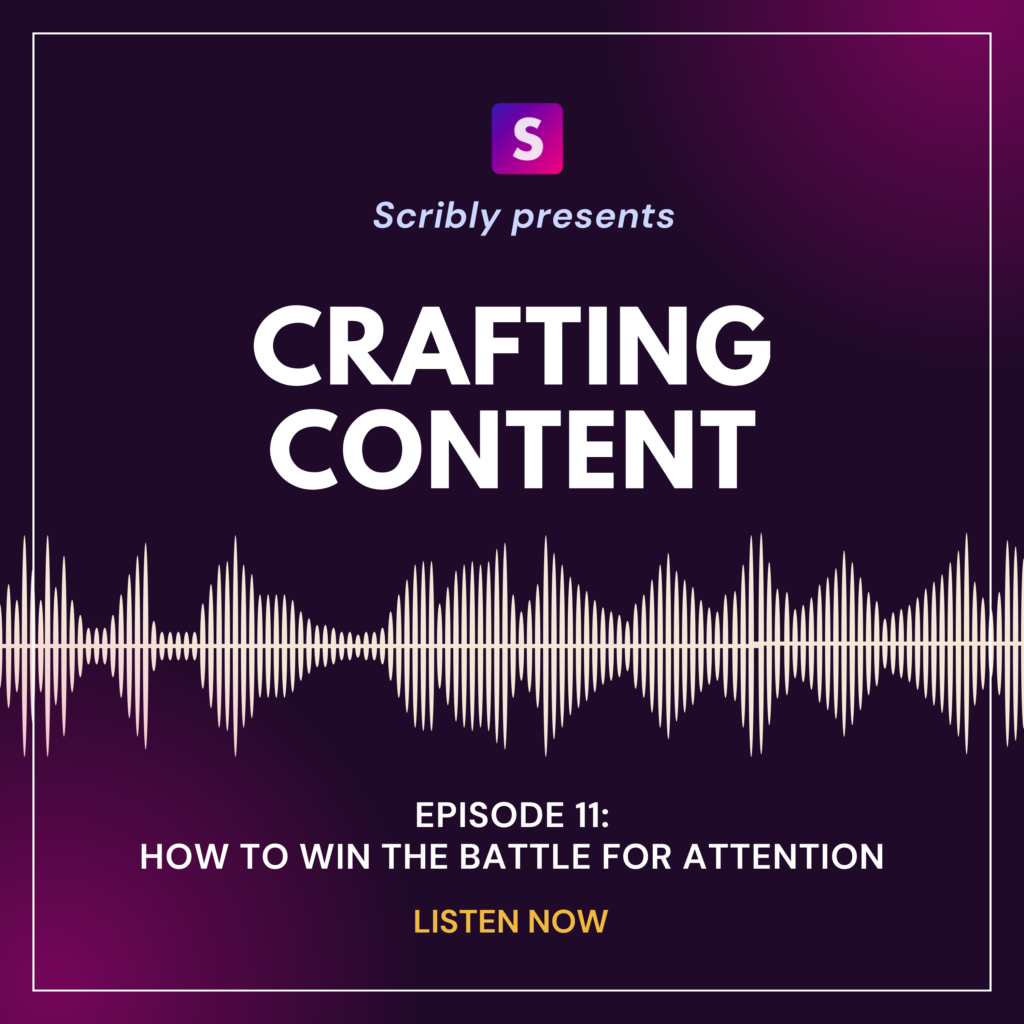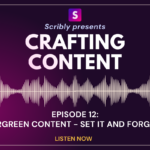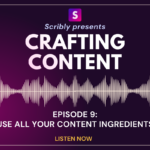Crafting Content, Episode 11 – A content marketing podcast from Scribly
Crafting Content Episode 11: How to win the battle for attention
Welcome to another episode of Scribly’s “Crafting Content” podcast! In today’s episode, we discuss how to get your content seen by the right people.
With so much content out there, so many different content channels competing for our attention, and a customer base with a dwindling attention span, it can be difficult to get your content seen by the right people at the right time. If you’re struggling with this, then listen up! We offer expert tips and tricks to help you reach your audience when and where it matters most.

You can listen to the full episode here: Scribly’s Content Marketing Podcast Episode 11: How to win the battle for attention
Episode 11: How to win the battle for attention [transcript]
Taylor: Hi everyone and welcome back to another episode of Crafting Content. Today, we are taking on a new topic and we have some new voices in your ears. We have Elle, Scribly’s Head of Content, Alex, Scribly’s in-house Content Writer and Account Manager, me — hi, I’m Taylor, Content and Accounts Manager — and joining us for the first time today is Ryan, Scribly’s owner. Hi, Ryan.
Ryan: Hi everybody. Glad to be on today.
Taylor: So, today we are going to discuss the battle for attention and how that relates to content marketing. And to do that, I am going to hand things over to Alex.
Alex: Yeah, so we’re talking about the battle for attention today, what that means, and what we can do about it. The obvious place to start is: what exactly do we mean by the battle for attention and how it relates to content marketing? So I’ll throw that question to you, Ryan. Thoughts?
Ryan: All right, thanks, Alex. Yeah. So, what do we mean by the battle for attention? It is an interesting question that we often get asked by our clients and people who are looking for content. Ultimately, we’re all in the business of getting as many people to see what it is we’re doing, what it is we’re writing about, and what we’re creating. Ultimately, the currency of today’s information out there is how many people you can get to see your content. That might bein the terms of a short video clip, or it might be in the terms of a longer form article.
It’s hard to really get your content noticed these days because of the sheer volume of things that are available across the entire spectrum of content. So this is where we look at it and we say: “All right, what is going to be the market? Who is going to be the person that’s going to be the most gripped by your piece of content?” Because you are really in a battle for that person or the right person’s attention across an entire spectrum of different elements. You’re talking social media, you’re talking video content, you’re talking YouTube. You’re even talking everything from Netflix and books. So we are in this interesting phase now where there is so much content being produced that it is work, and you have to really try to get your content noticed.
Alex: So, yeah, I think you touched on a number of points there, Ryan, and, like you said, I think one of the big things is just the sheer amount of content across different mediums that’s available. But do you think there are any other reasons why attention is so hard to capture now? And do you think it’s got harder over the past few years, or has it always been this difficult to get people’s eyeballs on your stuff?
Ryan: Yeah, absolutely. I mean, it’s been difficult no matter where you are, and it’s all about the effort that you put in. But in the day and age that we’re faced with now, it’s not just who’s writing the best blog, who’s writing the best email, who’s writing the best bit of content that’s getting put out there. You are dealing with a society or you’re dealing with a group of people who are focused on the shorter form content, who are focused on different social media platforms. We see a social media platform pop up once, and I don’t want to say once in every year, but it gets filled. So at some points, it does feel like people are more focused on different social media platforms, which then introduces a whole different area of content.
Every time there’s a new feature, it could be the start of an entire different branch of content. We see our side of the world, which is specifically the written content. But there are always opportunities to kind of enhance that, to make it more gripping, to make that piece of work more attention-grabbing, which is ultimately what you’re getting at. What we see is that people will look at what you put out there, but only 51% of people will read an entire thing you put out there.
Alex: Yeah. So of the people who’ve said that they’ve read an online article, only 51% of them have actually read it. And then, was it 22%? I think, have just read the headline, and then they’ve gone on social media and said “oh, I read this really interesting article about mistakes in content marketing”, and all they’ve read is the headline and maybe the first couple of lines. So, yeah, it’s super hard to get people to actually engage fully with content, and that’s after you’ve got them to click on it.
Taylor: I’m curious if you think it’s been harder to capture people’s attention post-pandemic, post-lockdown. I’ve noticed in life in general that there’s a bit more impatience since everyone was cooped up for two-plus years. And I wonder what that does for how we consume content and how we interact with brands and stuff. I think maybe there’s also something to be said for the fact that everyone was so chronically online for such a long period of time. And has that maybe changed our threshold for actually taking things in? I don’t know, what do you guys think?
Elle: I wonder if that just accelerated an already existing trend. We talk a lot about the different types of audiences that exist out there. So you’ve got what I would consider our parent’s generation, who are probably still active on Facebook and still think that you go onto Facebook to say “I’m having fish and chips for dinner”. And then you’ve got our generation, who’s maybe more a millennial on Instagram. And then you’ve got the incoming Gen Z generation who have grown up with technology but are also somewhat resistant to it. And, I guess it falls into the wider trend of they’re going back to using more eco-friendly products and they’re a lot less trusting of what they read online because they understand how it works and the algorithms that go into it. So I wonder if that was naturally going to happen anyway because of that generation. And then that generation spent so long online during the pandemic that suddenly that process, which should have taken 5, 10, 15 years, was sped up. And, so people are even more reticent to believe what they see online.
Ryan: So it’s interesting that the different generations have different ways of consuming media, and especially when it comes to that attention. And what necessarily those different demographics action is because ultimately we’re creating content because we want the reader to do something. It might just be simply read the article, but it also might be buy a product, sign up to a course, subscribe. There might be some action to what it is we’re creating. And those different formats and those different links and those different styles resonate with different audiences, both in the demographic of age.
But location, content platform, and then that content platform continues to inform the content media, and that kind of brings the whole circle over to, there are so many different options in so many different ways.
[listen to the podcast now for a full transcript]




